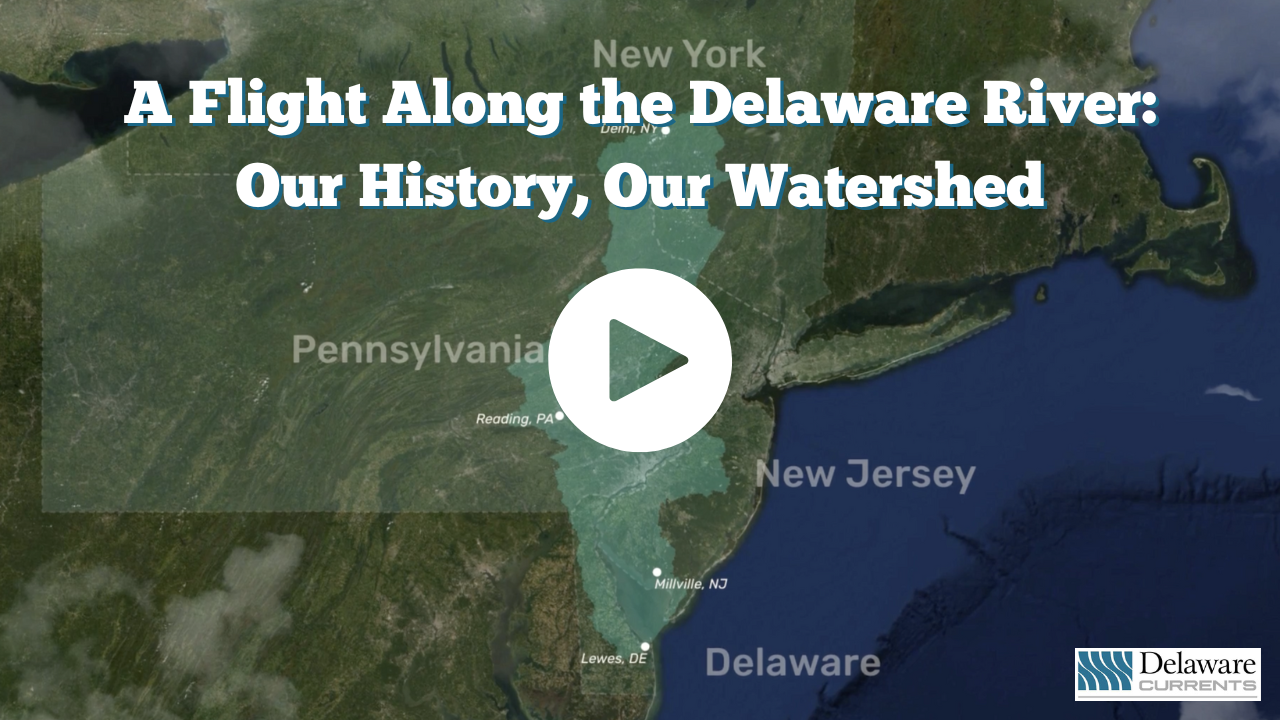
Editorial report: Assessing the effects of the Trump administration on the Delaware River watershed
| April 16, 2025
Right now, the Delaware River watershed is mired in a fog, and it’s not meteorological.
It’s born of the anxiety hundreds of thousands of people are feeling from a variety of causes but all emanating from the new administration in Washington.
Among many things, the anxiety stems from what’s happening to legal — and otherwise — immigrants; what jobs (both federal and private sector) could disappear if funding for them comes, even partially, from the feds; and what higher tariffs could mean to our ports on the Delaware.
The anxiety has spread across the academic community, the LGBTQ community and among veterans and retirees. Executive orders, counter orders, judges’ orders, DOGE cuts, pauses in funding, pauses in hiring and re-hiring — it all creates chaos.
Maybe that’s the plan?
A few weeks ago, we sought to take the pulse of the people who live and work or have worked in the environmental field, to ask about the effects of actions by the White House on the basin and the environmental work here, which has achieved so much in the past 50 years.
We sent a simple questionnaire to 20 potential respondents, smart folks who know a thing or two about the watershed and then some. We were initially surprised by the lack of response but to honor the four people who did respond, their complete answers are here.
We asked:
- What do you expect to be the concrete effects of the actions of the current administration as it defunds standing environmental practices?
- What is your assessment of the overall protection of the watershed in light of the rollbacks of environmental protections?
- Looking to the future, what do you see five years from now?
We realized that there might be two reasons why people did not respond. The first is obvious: Who knows what the answers to these questions might be? The other reason for a lack of response that bubbled up in off-the-record conversations was anxiety about possibly becoming a target of federal action.
If you’re the head of an environmentally focused organization, devoted to the mission of that organization, the last thing you want is to risk gaining the attention of the feds and face cuts in funding that would imperil your mission.
You have a responsibility to that mission — and to the people you employ, who might be paid with federal dollars — to keep your head down. In some off-the-record comments, leaders have told me that they are retooling the stated goals of their various projects to avoid the spotlight — specifically any mention of DEI, though one did state that the organization’s objectives will remain the same as they always have — to serve underserved communities.
Arcane and essential: State revolving funds
In this exploration of likely local impacts of administration actions are the as-yet-unknown effects on state revolving funds, which exist in all four watershed states.
We don’t hear much about those, but they house low-interest and long-term loan and grant programs for the big-ticket items that towns and cities need to improve their water infrastructure.
The federal agency that disburses the money that is like seed corn is the Environmental Protection Agency, and remember that the administration is aiming for a 65 percent cut to the EPA’s workforce and activities. Details are limited as to what those cuts will be.
For the Delaware River watershed, one of the biggest impacts could be the scarcity of funds to implement new improvements to the top-tier waste water treatment facilities in the estuary. They are facing new rules that the EPA will, we are told, promulgate for new dissolved oxygen levels for the urban corridor from Philadelphia to Wilmington.
Delaware Currents has written so many stories about dissolved oxygen. They are all gathered here. It’s called Series: Atlantic Sturgeon, because the sturgeon, an endangered species, is the root cause of the ongoing arguments about dissolved oxygen.
Shawn M. LaTourette, the commissioner of the New Jersey Department of Environmental Protection, talked about his concerns regarding the funding of essential big-ticket items that are waiting in the wings. On the plus side, he said he was recently at a gathering — the Environmental Council of the States — where cuts were part of the discussion. He said that “it looks like Congress will act to ensure vital environmental programs.”
“But there is a potential for cuts,” he added, reverting to caution, at a recent meeting in Camden.
A slightly more neutral view was expressed by David Zimmer, executive director of the New Jersey Infrastructure Bank.
“Terms and conditions continue to be distributed by Washington and there are currently more questions than answers. Things will settle down and pathways for funding will be solidified. Until that time, the state and its federal partners continue to coordinate to facilitate the financing of construction projects with funds within the program. As such, the Water Bank financing program continues to function effectively.”
National Park Service
No one story captures better the chaos coming out of Washington than the National Park Service and illustrates the anxiety that such chaos provokes. We have an inside view of what is happening because of the National Parks Conservation Association.
It offers not just a view of what’s happening at the National Park Service but the chaos across all federal agencies. This timeline includes events and orders that affect all federal agencies.
As a matter of past practice, federal employees are not allowed to talk publicly about hiring/firing in their agencies.
There are few federal agencies that have a voice as the NPS does in the NPCA. The NPS has that voice largely because it has been seriously underfunded and the NPCA exists as a way to garner support from beyond the federal government.
(One other outlet for NPS voices is this Facebook page for a group called Alt National Park Service.)
Here’s a timeline from the NPCA:
It started on Day One of the second Trump administration, Jan. 20, a hiring freeze was announced.
Jan. 23 -31: The hiring freeze led to the NPS rescinding more than 2,000 offers for positions across the country with peak visitor season approaching.
Jan. 28: What NPCA refers to as “Fork in the Road” buyouts. The administration offered federal workers buyouts to resign or stay in their jobs with no guarantee their positions would be safe.
Feb. 4: The administration orders agencies to identify and begin assessing property leases for possible termination, including visitor centers and public safety facilities.
Feb. 11: The administration directs federal agencies to submit reorganization plans and prepare for large-scale firings.
Feb. 14: The administration terminates 1,000 NPS employees — weeks or months into their new jobs — in their period of evaluation before increased job protection kicks in.
Feb. 18: The administration exempts up to 7,000 seasonal Park Service jobs from the hiring freeze, but with no timeline for reinstatement.
Feb. 22: The administration demands federal employees email five accomplishments from the previous week or face ramifications for not responding.
Feb. 24: The administration bans travel beyond 50 miles and caps government credit card spending at $1, stripping parks of the ability to buy even basic necessities like soap and toilet paper.
Feb. 25: More than 700 Park Service employees resign under the buyout offer — a devastating loss of expertise, experience and institutional knowledge.
March 13: The administration orders federal agencies to begin reductions-in-force, setting in motion a 90-day process.
March 17: As part of the RIF process, the administration sends early retirement and buyout incentive offers to Park Service employees, coercing staff to either retire or endure the threat of more firings while being stripped of essential tools and resources needed to do their jobs.
March 20: Due to a court order, the Park Service is authorized to reinstate 1,000 previously terminated probationary employees.
April 8: The U.S. Supreme Court pauses an order to reinstate fired federal employees.
April 14: The Park Service must submit new org charts, proposals for relocating staff and offices, potential contract cancellation and proposed staff reductions to the administration to be implemented by Sept. 30.
Renee Reber, NPCA’s clean water and climate program manager, said that despite all the confusion and headaches of the past three months, the biggest headache is the looming staff cuts. “We don’t know what that entails or what the percentage of staffing cuts will be demanded.”
Reber added on Tuesday that there’s nothing concrete being announced about those staff cuts. But the NPS has until September to make it happen. So, likely, more bad news.
In the four-state Delaware River watershed, there are 11 other Park Service units, ranging from the Delaware Water Gap National Recreation Area to Independence Park to Valley Forge to Hopewell Furnace, in Elverson, Pa. Not all are necessarily national parks. Some are wild and scenic rivers, some are national historic sites or national historic trails, for example.
It’s difficult to know how federal cutbacks might economically affect communities that benefit from tourists visiting the various NPS sites in the watershed.
Reber pointed out that the chaos and staffing cuts will impact the visitor experience, level of service, and safety. Staff are being lost at every level, she said, from operations and maintenance, to law enforcement, to park supervisors and beyond.
Oh no, not fracking again
The Delaware River basin Commission banned fracking in the watershed in February 2021.
Sigh of relief. It took almost 10 years for this to happen. Added to that: A lawsuit that Wayne Land and Mineral Group brought against the DRBC for its fracking ban, claiming overreach, was finally dismissed by a federal judge in February 2025.
But then this as reported by The River Reporter: Local representatives and Trump administration reopen fracking conversation for Delaware River Basin
Summing up, EPA Administrator Lee Zeldin came to a meeting in Northeast Pennsylvania, hosted by freshman U.S. Rep. Rob Bresnahan (PA, 8th District), where they discussed the need to unleash the natural gas resources in the Delaware River Basin.
Echoes of President Trump’s “Drill, baby, drill,” have caused concern all over the watershed — the Delaware River is the drinking water source for 14+ million people, though the New York City folks will likely be free from any threat about fracking since it is banned in New York State and all the water New York City uses is from NYCDEP reservoirs in the Catskills.
One of the most concerned is the Delaware riverkeeper, Maya van Rossum, who has rounded up 19 environmental organizations in an anti-fracking coalition, which includes many of the groups that fought for the ban in the first place.
You can find a copy of the letter (and a list of those orgs) they sent Bresnahan here.
It said that the fracking ban was based on science, that the meeting invited no environmental representatives and invited Bresnahan to tour areas outside of the watershed that have been negatively impacted by fracking.
Plenty of unknowns
I spoke with Christophe Tulou, executive director of the Center for the Inland Bays, which is not strictly in our watershed but nearby in Delaware.
The center’s average annual budget, including both capital and operating costs, is about $5 million. About $3 million is its operating budget; of that the center gets about $1.7 million from the federal government, via the Environmental Protection Agency.
A couple of things to remember: The center operates the same way many organizations do that receive federal dollars. They spend the already allocated money first, and then get reimbursed as the work is completed.
Tulou said that some of the bigger-ticket items they might undertake for water quality improvements (like stormwater management) are not likely to be planned since the funding is so up in the air.
On the plus side, he pointed out that the center is one of 28 National Estuary Programs, and some of them are in Republican states like Florida, Texas, Louisiana and Alabama, and that might offer some shield.
The host for the NEP in our watershed is the Partnership for the Delaware Estuary. In a letter dated April 2 to supporters, Kathy Klein, PDE’s executive director, gave an overview of the funding problems at PDE:
“Since late January over $1.25 million of our previously awarded funding has been paused. Additional funding we were excited to secure for 16 community-led, on-the-ground projects in Philadelphia, Camden, N.J., Chester, Pa., and Wilmington, Del., has also been paused.
“Not only are we unable to advance these mission-critical projects, but we’re also at risk of not being reimbursed for expenses already incurred prior to the funding freeze. Built into all these grants is critical funding needed to support our day-to-day operating costs.”
Getting back to the nuts and bolts of the Center for the Inlands Bay’s funding situation, of the center’s $1.7 million federal funds, it gets $850,00 core funding as a member in the National Estuary Program. And it recently got another $900,000 from the Bipartisan Infrastructure Law.
Tulou recollected that in the first Trump administration, the funding for the NEPs was cut, but Congress reinstated it. Now, though, a different Congress can’t really be relied on to come to anyone’s rescue.
Another possible plus: “We do such great work in community building, resilience building, and water quality, that there’s a good bet that, since water quality is big priority for this administration, we might be OK.”
But — and it’s a big but — “We are worried on a daily basis about our funding, that it could be cut off or paused,” Tulou said.
Both the Center and PDE are linchpins for community responses to threats from flooding, erosion, sea-level rise and the general effects of a changing climate.
Back in Camden, LaTourette emphasized: “We don’t know what the effects might be on clean water and safe drinking water. We need to continue to uplift communities by ensuring money at the federal, state and local levels.”
As funding becomes clearer — if it becomes clearer — let’s go back to the summation offered by Tulou from the Inland Bays:
“Much of the federal dollars we receive is 85 percent staff and staff support. Summer programs are moving forward as planned but no larger projects.
“If the money wasn’t available, we’d have little choice but to figure out how to close up shop.”






